As has long been the case, White voters are much more likely than those in other racial and ethnic groups to associate with the Republican Party. Hispanic and Asian voters tilt more Democratic. Black voters remain overwhelmingly Democratic.

However, there have been some shifts toward the GOP in most groups in recent years.
The Republican Party now holds a 15 percentage point advantage among White voters: 56% of non-Hispanic White voters identify with or lean toward the Republican Party, while 41% align with the Democratic Party.
- This double-digit lead for the GOP among White voters has held for more than a decade. The last time White voters were about equally split between the two parties was in 2008.
About six-in-ten Hispanic voters (61%) are Democrats or lean to the Democratic Party, while 35% are Republicans or Republican leaners.
- The Democratic Party’s edge among Hispanic voters over the last two years is somewhat narrower than it was in years prior.
Black voters continue to overwhelmingly associate with the Democratic Party, although the extent of the Democratic advantage among this group has fallen off over the last few years.
- Currently, 83% of Black voters are Democrats or lean Democratic, while 12% align with the GOP.
- As recently as 2020, the share associating with the Democratic Party was 5 percentage points higher. That somewhat larger edge in party affiliation had been in place for much of the last two decades.
About six-in-ten Asian voters (63%) align with the Democratic Party, while 36% are oriented toward the GOP.
- The balance of partisan association among Asian voters has changed little over the last few years.
Education and partisanship
The relationship between education and partisanship has shifted significantly since the early years of the 21st century.
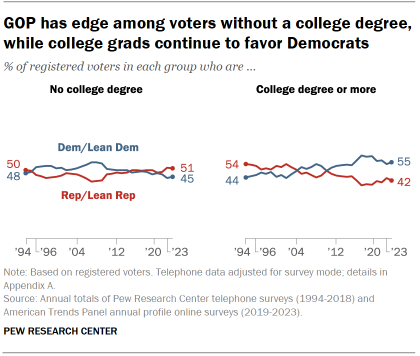
- The Republican Party now holds a 6 percentage point advantage over the Democratic Party (51% to 45%) among voters who do not have a bachelor’s degree. Voters who do not have a four-year degree make up a 60% majority of all registered voters.
- By comparison, the Democratic Party has a 13-point advantage (55% vs. 42%) among those with a bachelor’s degree or more formal education.
This pattern is relatively recent. In fact, until about two decades ago the Republican Party fared better among college graduates and worse among those without a college degree.
In the last years of George W. Bush’s presidency and the first year of Barack Obama’s, Democrats had a double-digit advantage in affiliation over Republicans among voters without a college degree. For example, in 2007, 56% of voters without a degree were Democrats or leaned Democratic, while 42% were Republicans or GOP leaners. This group was narrowly divided between the two parties for most of the next 15 years, but in the last few years it has tilted more Republican.
College graduates moved in the opposite direction, becoming more Democratic over this same period.
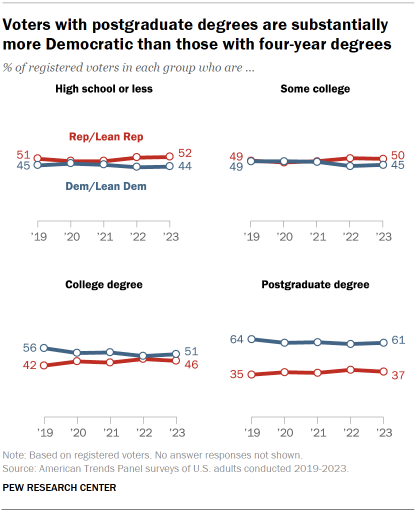
- Since 2017, the gap in partisanship between college graduates and those without a degree has been wider than at any previous point in Pew Research Center surveys dating back to the 1990s.
Voters with postgraduate degrees are even more Democratic than those with bachelor’s degrees. About six-in-ten registered voters who have a postgraduate degree (61%) identify with or lean toward the Democratic Party, while 37% associate with the Republican Party. Voters with a bachelor’s degree but no graduate degree are more closely divided: 51% Democratic, 46% Republican.
Voters with a high school degree or less education and those who have attended some college but do not have a bachelor’s degree both tilt Republican by similar margins.
Education, race and partisanship
White voters are far more polarized along educational lines than are Hispanic and Black voters.
White voters by education
By nearly two-to-one (63% vs. 33%), White voters without a bachelor’s degree associate with the Republican Party.
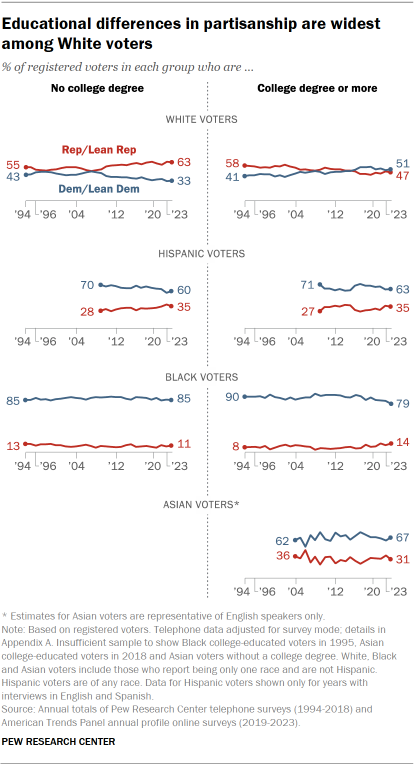
The GOP’s advantage among this group has remained relatively steady over the last several years but reflects a major shift since 2009. This group is now substantially more Republican-oriented than at any prior point in the last three decades.
Today, White voters with a bachelor’s degree are closely divided between associating with the Democratic Party (51%) and the Republican Party (47%). Prior to 2005, this group had a clear Republican orientation.
Hispanic voters by education
In contrast, there are no meaningful differences in the partisan leanings of Hispanic voters with and without bachelor’s degrees. Democrats hold a clear advantage in affiliation among both groups of Hispanic voters, although the share of Hispanics (both those with and without bachelor’s degrees) who align with the Democratic Party has edged lower in recent years.
Black voters by education
Black voters both with (79%) and without college degrees (85%) remain overwhelmingly Democratic in their partisan affinity.
Black college graduates are somewhat less closely aligned with the Democratic Party now than they were for most of the prior three decades (for most of this period, 85% or more of Black college graduate voters affiliated with the Democratic Party).
Asian voters by education
Two-thirds of Asian voters with a college degree align with the Democratic Party; 31% associate with the Republican Party. The partisan balance among Asian voters with a college degree has remained largely the same over our last two decades of surveys. (Asian American voters without a college degree are a smaller group, and sample sizes do not allow for reporting trends among this group.)
Partisanship by race and gender
Visit the chapter on partisanship by gender, sexual orientation and marital and parental status for discussion of overall trends among men and women.

Six-in-ten White men who are registered voters identify as Republicans or lean Republican, as do 53% of White women voters.
The balance of partisanship among White women voters has tilted toward the GOP in recent years, but it was more divided in 2017 and 2018.
Among Hispanic voters, about six-in-ten men (61%) and women (60%) associate with the Democrats. Hispanic women voters have become somewhat less Democratic in recent years (down from 74% in 2016).
About eight-in-ten Black voters – both women (84%) and men (81%) – are Democrats or Democratic leaners.
About six-in-ten men (61%) and women (64%) among Asian voters identify as Democrats or lean toward the Democratic Party. (There is insufficient sample to show longer-term trends among Asian voters by gender.)
Partisanship across educational and gender groups by race and ethnicity
Among White voters, there are wide differences in partisanship by gender, by educational attainment – and by the combination of these.
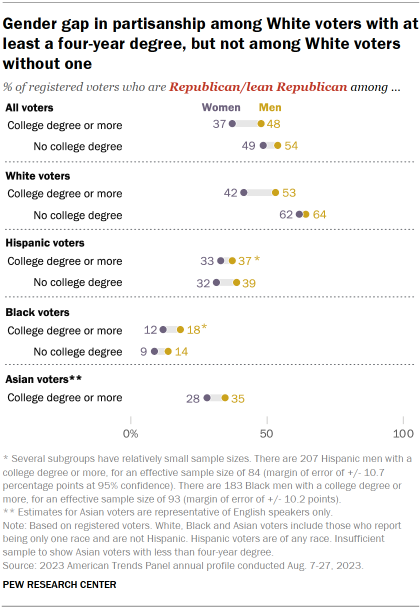
- Among White voters without a college degree, 64% of men and 62% of women say they identify as or lean toward the Republican Party (about a third of each associate with the Democrats).
- White men with a college degree also tilt Republican among voters, though to a lesser extent (53% are Republicans or lean Republican, 45% are Democrats or lean Democratic).
- In contrast, White women with a college degree are more Democratic than Republican by 15 percentage points (42% Republican or Republican leaning, 57% Democrat or lean Democrat).
Among Black and Hispanic voters, there are only modest differences in partisanship across the combination of gender and education. In both groups, there are no significant differences between men with and without college degrees, or between their women counterparts. (Because Asian American voters without a college degree are a small group, sample sizes do not allow comparing college and non-college Asian men and women.)
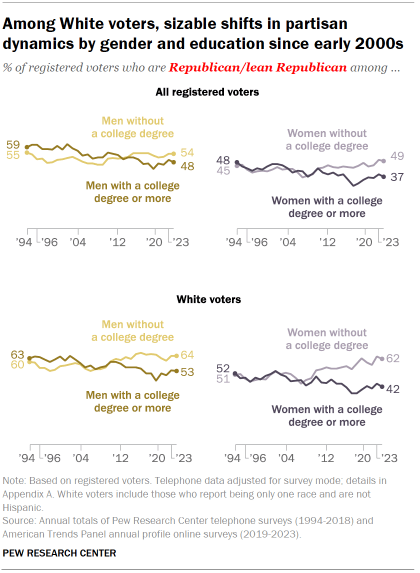
This dynamic has changed over time, as college-educated White men and women have grown more Democratic and those with less formal education have grown more Republican.
Then
As recently as 15 years ago, there were sizable gender gaps in partisanship among both college and non-college White voters. In both cases, men were substantially more likely than women to associate with the Republican Party.
But, at that time, there was not a substantial difference in the partisanship of college and non-college White voters – for either women or men.
Now
Today, there is no gender gap in partisanship among non-college White voters, while there is a gender gap among college graduate White voters. The difference in partisanship between White women voters who have a college degree and those who do not, in particular, is quite large.
By contrast, there is little variation in the partisanship of Black and Hispanic voters by these characteristics, and the relationship has varied less over time.


